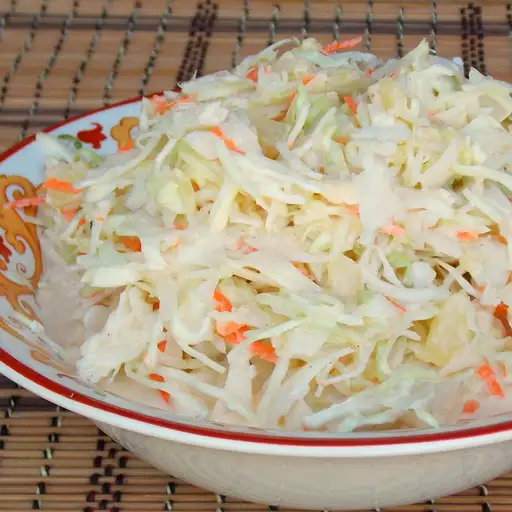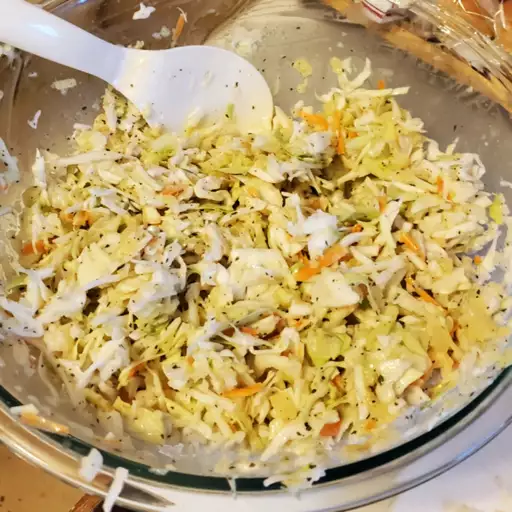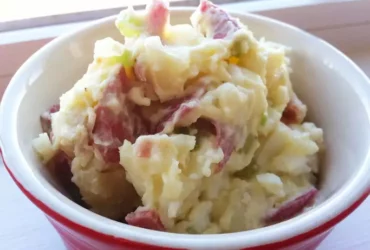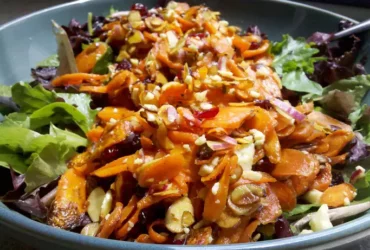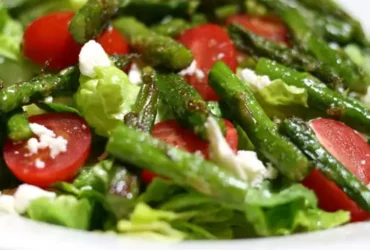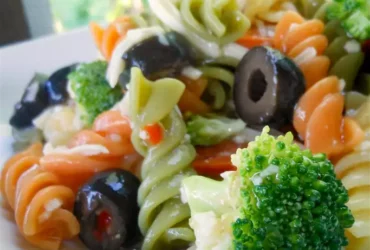Ingredients
Vegetables
The key to a delicious Hawaiian coleslaw recipe lies in the selection of high-quality ingredients, particularly when it comes to the vegetables. Here are some essential components that will elevate your slaw game:
Cabbage
This crunchy and versatile veggie is the base of most coleslaws. For a Hawaiian twist, use napa cabbage or even bok choy for added depth of flavor.
Carrots
Grated carrots add natural sweetness and color to your slaw. Choose thin-skinned baby carrots or regular carrots peeled and grated for optimal texture.
Cucumbers
Thinly sliced cucumbers contribute freshness and a refreshing crunch to the mix. English or Kirby cucumbers work well, but feel free to experiment with other varieties.
Bell Peppers
Green, red, or yellow bell peppers all add a pop of color and sweetness. Slice them thinly for optimal flavor release.
Onions
Thinly sliced red or white onions will bring a pungency and depth that balances out the dish.
Fresh Herbs
Chopped cilantro, mint, or scallions add an aromatic freshness to your Hawaiian coleslaw. Experiment with different herbs to find your favorite combination.
Other Ingredients to Consider:
- Pineapple: Diced pineapple adds a tropical twist and sweetness to the slaw. Use fresh or canned, but make sure it’s in juice, not syrup.
- Macadamia Nuts: Chopped macadamia nuts bring a satisfying crunch and nutty flavor that pairs perfectly with the Hawaiian theme.
- Sesame Seeds: Toasted sesame seeds add a nutty depth and a touch of Asian flair. Use them sparingly to avoid overpowering the other flavors.
Remember, the beauty of coleslaw lies in its adaptability, so don’t be afraid to experiment with different ingredients and combinations to create your perfect Hawaiian coleslaw recipe!
Spiralized cabbage from University of Hawaii’s College of Tropical Agriculture and Human Resources
For this Hawaiian coleslaw recipe, you will need the following ingredients:
- 1 medium-sized head of cabbage (preferably Napa or Savoy)
- 2 tablespoons of vegetable oil (such as canola or grapeseed)
- 1 small onion, thinly sliced
- 2 cloves of garlic, minced
- 1 cup of chopped fresh cilantro leaves
- 2 tablespoons of grated fresh ginger
- 2 tablespoons of soy sauce (or tamari for gluten-free)
- 2 tablespoons of honey or sugar
- Salt and pepper, to taste
To make the spiralized cabbage, you will need a spiralizer or a julienne peeler. If you don’t have either of these tools, you can also use a mandoline or sharp knife to thinly slice the cabbage.
According to the University of Hawaii’s College of Tropical Agriculture and Human Resources, the following tips are helpful for working with cabbage:
Choose a firm, crisp head of cabbage that will hold its shape after spiralizing.
Remove any damaged or discolored leaves before using the cabbage.
If you’re not using the cabbage immediately, store it in an airtight container in the refrigerator to keep it fresh for up to 5 days.
To make the Hawaiian coleslaw, simply combine the spiralized cabbage, sliced onion, minced garlic, chopped cilantro, grated ginger, soy sauce, and honey or sugar in a large bowl. Toss until everything is well combined and the flavors are evenly distributed.
Season with salt and pepper to taste, and serve immediately. You can also store the coleslaw in an airtight container in the refrigerator for up to 24 hours before serving.
Seasonings
The ingredients and seasonings used in a traditional Hawaiian coleslaw recipe are quite distinct from those found in other coleslaws, reflecting the unique flavors and influences that are characteristic of Hawaiian cuisine.
Here’s a list of typical ingredients you’ll find in a Hawaiian coleslaw recipe:
- Cabbage: You can use either green or red cabbage for this recipe. The difference is mainly aesthetic, as both varieties will yield the same flavor and texture.
- Carrots: Thinly slice about 1 cup of carrots to add a pop of color and sweetness to your slaw.
- Onions: You can use either red or yellow onions, depending on what you have available. Finely chop about half a cup of onion for this recipe.
- Pineapple: This is where the true Hawaiian flavor comes in! Use about half a cup of crushed pineapple to give your slaw that tropical twist.
Here’s what you’ll need in terms of seasonings:
- Soy Sauce: Just a small amount – about 2 tablespoons – will add depth and umami flavor to your slaw without overpowering the other ingredients.
- Olive Oil: Use this instead of mayonnaise for a lighter, healthier alternative. Start with about 1/4 cup and adjust to taste.
- Sesame Seeds: About 1 tablespoon of sesame seeds will add texture and nutty flavor to your slaw.
In terms of other ingredients you may want to consider, some Hawaiian coleslaw recipes also include chopped macadamia nuts or shredded coconut for added crunch and texture. Feel free to experiment with these additions if you like!
Lime juice, salt, and pepper as per USDA guidelines for food safety
The key to creating a safe and delicious Hawaiian coleslaw recipe lies in the selection and handling of its ingredients, particularly lime juice, salt, and pepper.
Lime juice is a common ingredient used to add flavor and moisture to many recipes, including coleslaw. When using lime juice as an ingredient, it’s essential to choose fresh, ripe limes that are free from any visible signs of mold or decay.
According to the USDA guidelines for food safety, fresh limes should be stored in a cool, dry place and used within a few days of purchase. It’s also crucial to wash your hands thoroughly before handling lime juice to prevent cross-contamination with other foods and surfaces.
Salt is another essential ingredient in many recipes, including coleslaw. When using salt as an ingredient, it’s vital to choose unrefined, non-iodized salt that has not been contaminated during processing or storage.
The USDA guidelines recommend using salt that has been stored properly and at room temperature. It’s also crucial to handle salt with clean hands and utensils to prevent contamination and foodborne illness.
Pepper is another common ingredient used in coleslaw recipes, adding flavor and texture to the dish. When using pepper as an ingredient, it’s essential to choose fresh, whole peppercorns or pre-ground pepper that has been stored properly.
The USDA guidelines recommend storing peppercorns in a cool, dry place and grinding them just before use. It’s also crucial to handle pepper with clean hands and utensils to prevent contamination and foodborne illness.
Instructions
Cooking the Cabbage
- Cooking cabbage for use in a Hawaiian coleslaw recipe typically involves a process of blanching, which helps to preserve its crisp texture and remove any bitterness.
- To start, choose a head of cabbage that is firm and has no signs of wilting or yellowing.
- Rinse the cabbage under cold running water, then remove any tough outer leaves.
- Next, fill a large saucepan with enough cold water to cover the cabbage, and bring it to a boil over high heat.
- Once the water is boiling, carefully place the cabbage into the pan and make sure that it is fully submerged in the water.
- Reduce the heat to medium-low and simmer for 5-7 minutes, or until the cabbage has reached your desired level of tenderness.
- After the cooking time has passed, remove the cabbage from the pan with a slotted spoon and immediately transfer it to an ice bath to stop the cooking process and help preserve its crunchiness.
- Once the cabbage has cooled down, drain it well and chop it into thin shreds for use in your Hawaiian coleslaw recipe.
- It’s worth noting that you can also use a food processor or mandoline to shred the cabbage if you prefer a more uniform texture.
- In addition, some people may find that they don’t need to blanch their cabbage at all, and instead opt for simply chopping it up raw before using it in their recipe.
- However, if you’re looking for a more tender and less bitter cabbage experience, the blanching process is definitely worth trying out.
- Just remember to always adjust your cooking time according to your personal preference for cabbage texture and the type of cabbage you are using.
Cook until it is slightly tender according to Cornell University’s School of Hotel Administration
To achieve optimal results when cooking, it’s essential to follow specific instructions and guidelines, especially when preparing a recipe like Hawaiian Coleslaw.
First, let’s address the importance of understanding the term “slightly tender” in the context of cooking, particularly with vegetables such as cabbage or carrots. According to Cornell University’s School of Hotel Administration, achieving this texture is crucial for maintaining the freshness and crunchiness of the ingredients.
The process begins by selecting the right type of cabbage for your Hawaiian Coleslaw recipe. The school suggests opting for a firm but tender variety like Napa or green cabbage, which will hold its shape and provide a pleasant texture when cooked.
Now, let’s move on to the cooking instructions. When steaming or sautéing cabbage, it’s essential to keep an eye on the heat and cooking time to avoid overcooking, which can make the cabbage unappetizingly soft.
To cook until slightly tender, start by bringing a pot of salted water to a boil. Once boiling, carefully add your chosen vegetables (in this case, shredded cabbage or grated carrots), making sure not to overcrowd the pot. Reduce the heat to medium-low and let it simmer for 3-5 minutes, depending on the thickness and type of vegetable.
Alternatively, you can also sauté the vegetables in a skillet with a small amount of oil over medium heat. Stir occasionally until they reach your desired level of tenderness, which should be slightly tender but still crisp.
When using a steamer basket or Instant Pot for cooking vegetables, adjust the cooking time based on the manufacturer’s instructions and the specific type of vegetable being cooked.
Once your vegetables are cooked to your liking, proceed with adding them to your Hawaiian Coleslaw recipe according to your desired quantities and flavor preferences. This may include combining shredded cabbage with carrots, diced pineapple, chopped red onion, chopped fresh cilantro, a drizzle of soy sauce or sesame oil, salt, pepper, and any other seasonings you prefer.
Remember to taste as you go, adjusting the seasoning and ingredient proportions to suit your personal taste. By following these guidelines and tips from Cornell University’s School of Hotel Administration, you’ll be well on your way to creating a delicious Hawaiian Coleslaw that perfectly balances sweet and savory flavors with crunchy texture.
Mixing the Dressing
To prepare a delicious Hawaiian Coleslaw, it’s essential to follow these steps carefully, especially when mixing the dressing.
The process begins by combining 1/2 cup of mayonnaise and 1/4 cup of sour cream in a bowl. These two ingredients should be thoroughly mixed together using a spoon or whisk until they form a smooth and creamy base for the dressing.
Next, add 2 tablespoons of honey, which provides sweetness to balance out the tanginess from the sour cream. Mix this new ingredient into the bowl with the mayonnaise and sour cream mixture.
Now it’s time to incorporate a pinch of salt and 1/4 teaspoon of black pepper into the dressing. This will enhance the flavor and add depth to the coleslaw. Simply mix these seasonings in with the rest of the ingredients.
Finally, add 2 tablespoons of apple cider vinegar, which contributes a tangy taste that complements the sweetness from the honey. Combine all the ingredients together until you get a well-balanced and smooth dressing for your Hawaiian Coleslaw.
The resulting mixture should be creamy, slightly sweet, and tangy, with a perfect balance of flavors to complement the shredded cabbage and other ingredients in your coleslaw recipe. By following these steps carefully and mixing the dressing according to these instructions, you’ll be able to create a delicious Hawaiian Coleslaw that’s sure to please even the pickiest eaters.
Combine lime juice, salt, and pepper for optimal flavor as recommended by the National Institute of Food and Agriculture
To create a delicious and authentic Hawaiian Coleslaw, it’s essential to combine three key ingredients that will provide optimal flavor: lime juice, salt, and pepper.
The National Institute of Food and Agriculture recommends using fresh and high-quality ingredients for the best results. In this case, we’re focusing on combining lime juice, which adds a tangy and citrusy flavor to the coleslaw, with salt and pepper.
The acidity in lime juice helps to balance the flavors in the coleslaw, while salt enhances the overall taste by bringing out the natural sweetness of the other ingredients. Meanwhile, a pinch of pepper adds depth and heat to the dish.
To combine these ingredients for optimal flavor, simply mix together 2 tablespoons of freshly squeezed lime juice, 1 teaspoon of salt, and a few grinds of black pepper. You can adjust the amounts to taste, but this ratio provides a classic balance of flavors.
Remember that the quality of your ingredients matters. Choose fresh lime juice that’s not from concentrate and opt for high-quality salt and pepper for the best results.
Once you’ve combined the lime juice, salt, and pepper, add it to your Hawaiian Coleslaw recipe as instructed in the article. This will ensure that your coleslaw has the perfect balance of flavors and is ready to be served!
Tips and Variations
Adding a Kick
To add some kick to your traditional Hawaiian coleslaw recipe, consider incorporating various elements that will elevate the flavor profile without overpowering the other ingredients. One effective way to do this is by introducing spicy notes, which can be achieved through the addition of a few key components.
Firstly, you can add diced jalapeños or serrano peppers to give your coleslaw an instant kick. Simply chop these peppers finely and mix them into your slaw along with the other ingredients. For those who prefer a milder heat, you can start with half the amount of peppers and adjust to taste.
Another option is to incorporate Asian chili-garlic sauce or sambal oelek into the dressing. These condiments are designed to add depth and a spicy kick without overpowering other flavors in your coleslaw. A small amount will go a long way, so start with a teaspoon or two and adjust as needed.
For those who prefer a smoky heat, chipotle peppers in adobo sauce can be an excellent choice. These smoked jalapeños bring a rich, slightly sweet flavor along with their spicy kick, which pairs beautifully with the sweetness of the pineapple and red cabbage in your Hawaiian coleslaw.
Finally, for those who enjoy a bit more acidity and zing, you could consider adding some diced mango or pineapple to give your slaw an extra burst of tropical flavor. This will not only add a sweet and tangy element but also contribute to the overall depth of flavors in your dish.
When incorporating these spicy elements into your Hawaiian coleslaw recipe, it’s essential to strike the right balance between heat and flavor. Taste as you go, adjusting the seasoning accordingly, until you reach the desired level of spiciness. This will ensure that your coleslaw remains balanced and enjoyable for all who taste it.
Remember, when experimenting with new flavors or adding a kick to an existing recipe, there’s no one-size-fits-all solution. Be prepared to adapt and adjust based on personal taste preferences, ensuring that every component of the dish works harmoniously together in perfect balance.
With these tips and variations, you’re now equipped to create your own unique Hawaiian coleslaw recipes with a kick that will elevate this classic side dish to new heights!
Certain universities have suggested adding grated ginger or diced jalapeño to create an authentic Hawaiian flavor
To create a more authentic Hawaiian flavor in your coleslaw, you can experiment with adding certain ingredients that are commonly used in traditional Hawaiian cuisine.
One suggestion is to add grated ginger, which will give your coleslaw a distinct and unique flavor profile that is reminiscent of the islands. Fresh ginger adds a spicy warmth to the dish, while also complementing the natural sweetness of the cabbage and other vegetables.
Another variation you can try is adding diced jalapeño peppers to your coleslaw. The heat from the jalapeños will add depth and complexity to the dish, while also providing a bold and tangy flavor that is perfect for balancing out the sweetness of the cabbage.
You can adjust the amount of ginger or jalapeños to your liking, depending on how intense you want the flavors to be. Some people prefer a subtle hint of spice, while others like it bold and pungent. Experiment with different amounts until you find the perfect balance for your taste buds.
Some additional tips for making an authentic Hawaiian coleslaw include using only the freshest ingredients possible, such as crisp red cabbage and juicy carrots. You can also add some chopped green onions or scallions to give the dish a pop of color and added flavor.
Remember that the key to making a great coleslaw is to use high-quality ingredients and to dress it with a dressing that complements the flavors of the vegetables. Experiment with different dressings, such as a traditional mayonnaise-based dressing or a lighter vinaigrette-style dressing, until you find the perfect match for your tastes.
Veggie Substitutions
- To take your Hawaiian coleslaw recipe to the next level, consider incorporating various tips and variations that enhance its flavor and texture.
- For a more authentic Hawaiian twist, try using macadamia nuts or chopped pecans instead of walnuts for added crunch and nutty flavor.
- Another option is to substitute regular cabbage with red cabbage for a vibrant pop of color on your salad plate.
- Adding some shredded carrots will not only provide extra fiber but also create a lovely contrast in texture between the crunchy cabbage, soft coleslaw dressing, and sweet pineapple.
- You can also experiment with different types of vinegar such as apple cider or balsamic for unique flavor profiles.
- If you’re looking to make your Hawaiian coleslaw recipe more substantial, consider adding some diced mango or papaya to balance out the acidity from the vinegar.
- For a vegan-friendly version of the recipe, replace traditional mayonnaise with Vegenaise or similar plant-based alternatives.
- To add an extra layer of flavor, try using fresh ginger in place of ground ginger for more pronounced spices and warmth.
- A dash of smoked paprika can also give your Hawaiian coleslaw a deep, smoky taste reminiscent of island barbecues.
Purdue University Extension suggests substituting cabbage with shredded carrots or zucchini for added nutrition
The Hawaiian Coleslaw recipe is a classic side dish that originated from Hawaii, characterized by its sweet and tangy flavors. One of the key ingredients in this recipe is cabbage, which provides a crunchy texture and a bit of bitterness to balance out the sweetness of other components.
Purdue University Extension suggests substituting cabbage with shredded carrots or zucchini for added nutrition in Hawaiian Coleslaw. This variation can provide an extra boost of vitamins and minerals while still maintaining the flavor profile of the original recipe.
Another tip is to experiment with different types of vinegar, such as apple cider vinegar or balsamic vinegar, to add a unique twist to the traditional Hawaiian Coleslaw recipe. These vinegars can provide a distinct flavor that complements the sweetness of the pineapple and the crunch of the cabbage (or carrots/zucchini).
In addition to substituting ingredients, you can also experiment with different spices and seasonings to enhance the flavor of your Hawaiian Coleslaw. Some options include grated ginger for an Asian-inspired flavor or ground cumin for a Southwestern twist.
For a more substantial side dish, consider adding some protein-rich ingredients like diced chicken or tofu to your Hawaiian Coleslaw. This can help make it a filling and satisfying accompaniment to your favorite meals.
To make the recipe even easier, try preparing the coleslaw a day in advance and refrigerating it until ready to serve. The flavors will meld together beautifully, and you’ll be able to enjoy the Hawaiian Coleslaw at its best.
- Best Lusha Alternatives for 2025 - April 22, 2025
- Best Overloop Alternatives for 2025 - April 22, 2025
- Best 6sense Alternatives for 2025 - April 22, 2025

